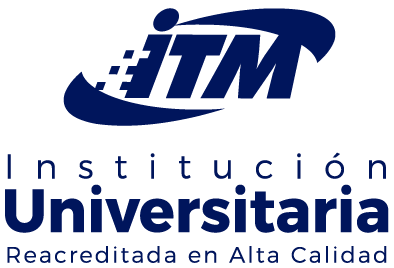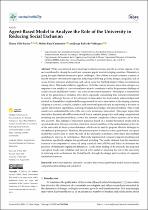Mostrar el registro sencillo del ítem
Agent-Based Model to Analyze the Role of the University in Reducing Social Exclusion
| dc.contributor.author | Villa-Enciso, Eliana | |
| dc.contributor.author | Ruiz-Castañeda, Walter | |
| dc.contributor.author | Robledo Velásquez, Jorge | |
| dc.date.accessioned | 2023-09-22T14:14:37Z | |
| dc.date.available | 2023-09-22T14:14:37Z | |
| dc.date.issued | 2023 | |
| dc.identifier.citation | Villa-Enciso, E.; Ruiz-Castañeda, W.; Robledo Velásquez, J. Agent-Based Model to Analyze the Role of the University in Reducing Social Exclusion. Sustainability 2023, 15, 12666. https://doi.org/10.3390/su151612666 | spa |
| dc.identifier.uri | http://hdl.handle.net/20.500.12622/6133 | |
| dc.description.abstract | While conventional innovation has boosted economic growth in certain regions, it has not contributed to closing the social and economic gap in most developing countries. Humanity is going through a historic moment of great challenges. One of them is social exclusion, a matrix of factors that prevent human beings from achieving well-being: poverty, hunger, inequality, lack of access to basic resources and services, and lack of social ties that help improve these circumstances, among others. This study holds two hypotheses: (1) in this context, inclusive innovation emerges as a response to the inability of conventional innovation to contribute to solve the persistent challenge of social exclusion and (2) universities—key actors in innovation dynamics—should play a fundamental role in the generation of inclusive innovation, especially considering their natural commitment to society. Although the role of the university in innovation has been widely acknowledged and studied, no formal theoretical model has represented inclusive innovation in developing countries adopting a systemic, complex, adaptive, and functional approach and incorporating a diversity of agents, interactions, capabilities, learning processes, knowledge, and directionalities—this would enable us to understand the role of the university in inclusive innovation. This paper argues that innovation dynamics should be understood from a systemic perspective and using computational modeling and simulation methods, so that the inherent complexity of these systems can be taken into account. The analysis of innovation scenarios based on a formal theoretical model and its operationalization through computer simulation should contribute to the understanding of the role of the university in these system dynamics, which can be used to propose effective strategies to strengthen its participation. Therefore, this paper proposes a formal systemic agent-based conceptual model that can be used to study the role of the university in inclusive innovation and establish guidelines to improve its performance. This study implemented standard computer modeling and simulation, specifically adapted for agent-based modeling. The results obtained from the simulation scenarios were comparatively analyzed using statistical tests (ANOVA and Tukey) to determine the presence of statistically significant differences. As the main finding of the research, the proposed conceptual model was validated and proved to be useful for studying the role of the university in reducing social exclusion in the Global South, through the design and execution of computer simulation scenarios. | eng |
| dc.language.iso | eng | spa |
| dc.title | Agent-Based Model to Analyze the Role of the University in Reducing Social Exclusion | spa |
| dc.subject.keywords | innovation systems; university; inclusive innovation; agent-based model; social exclusion; computational modeling and simulation | spa |
| dc.type | journal article | spa |
| dc.type.local | Revista | spa |
| dc.identifier.doi | https://doi.org/10.3390/su151612666 | spa |


